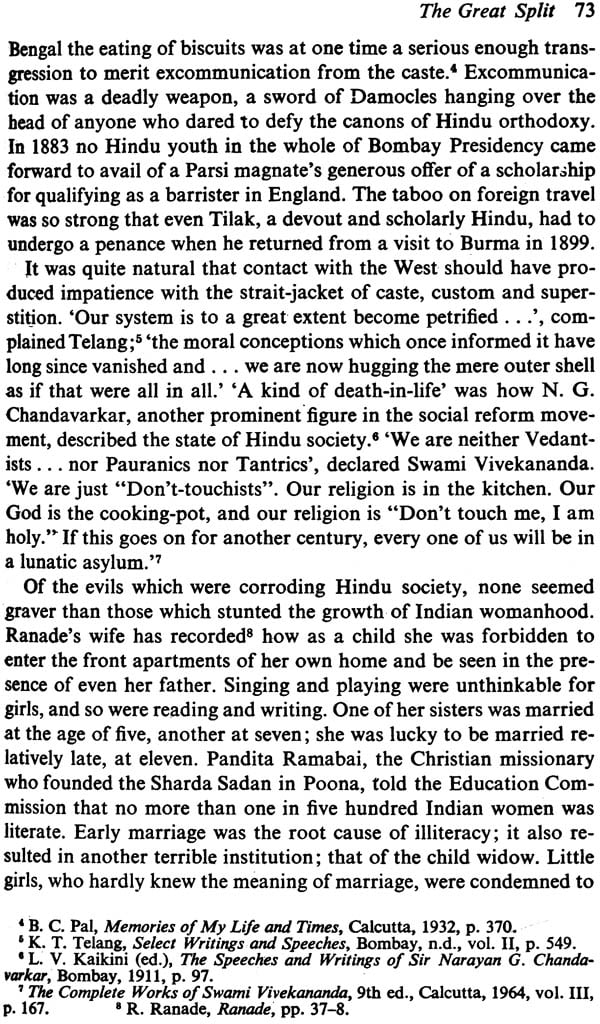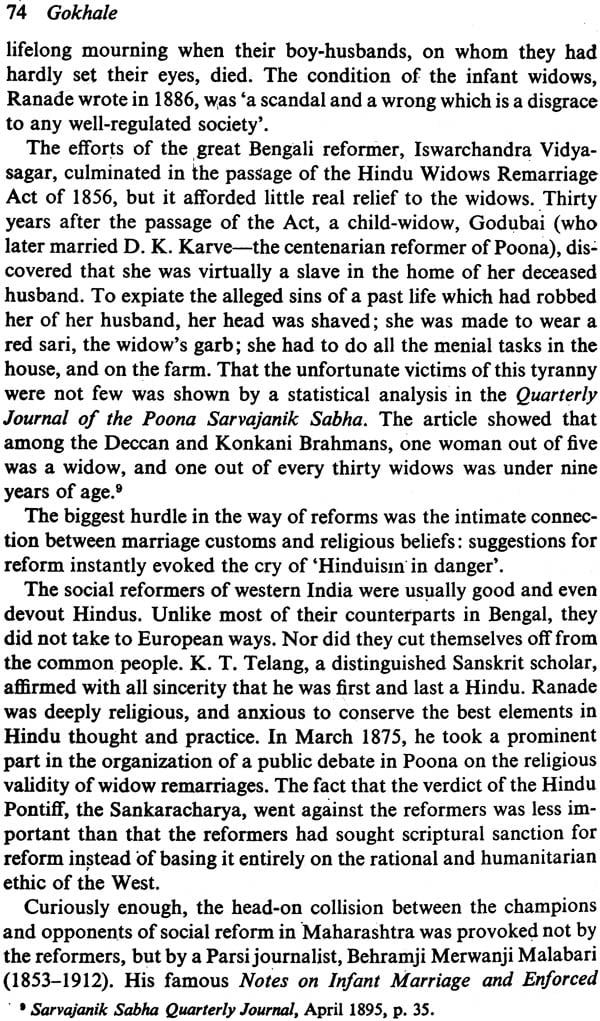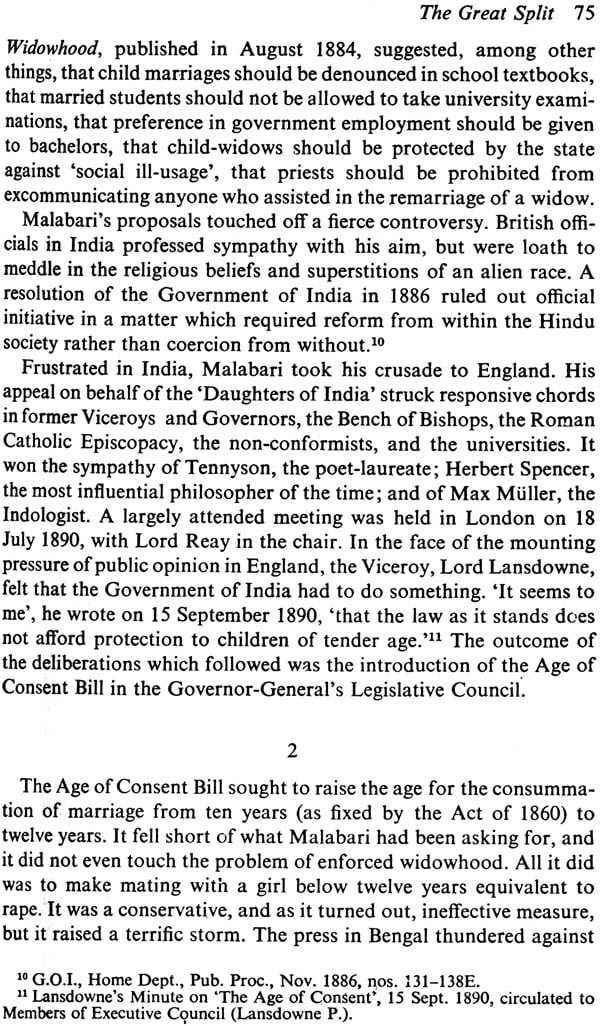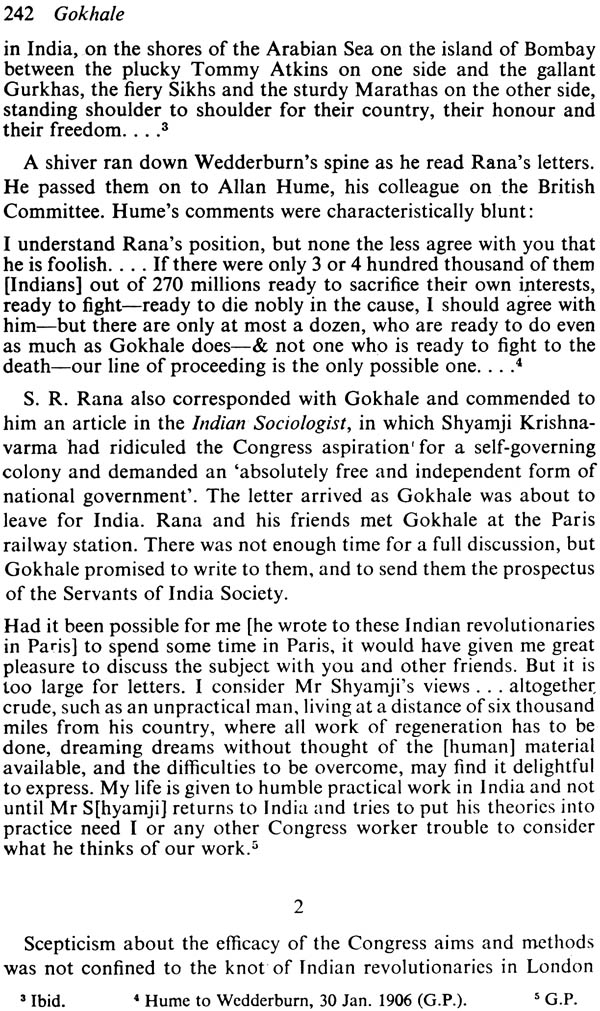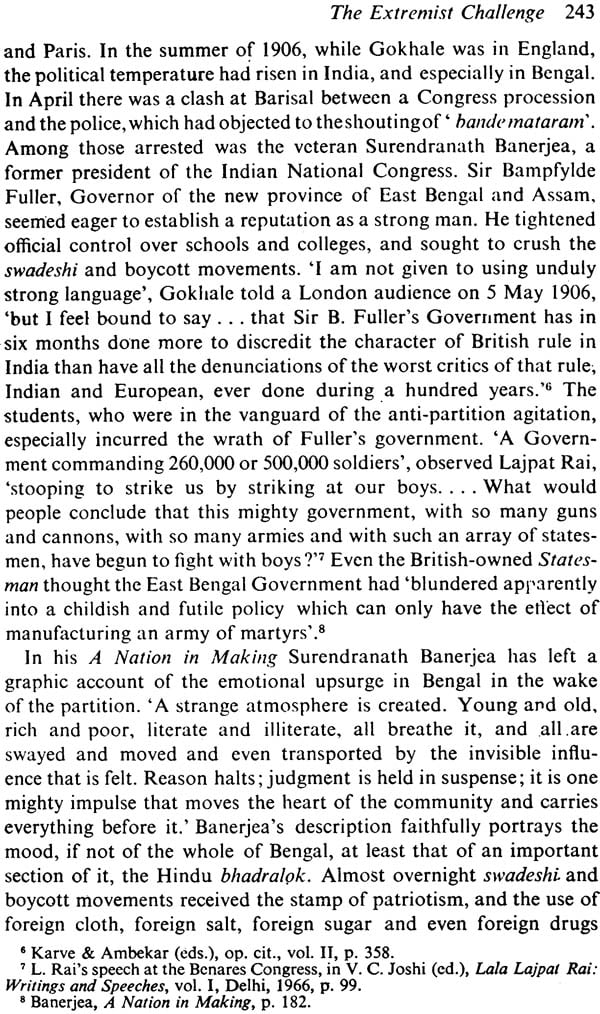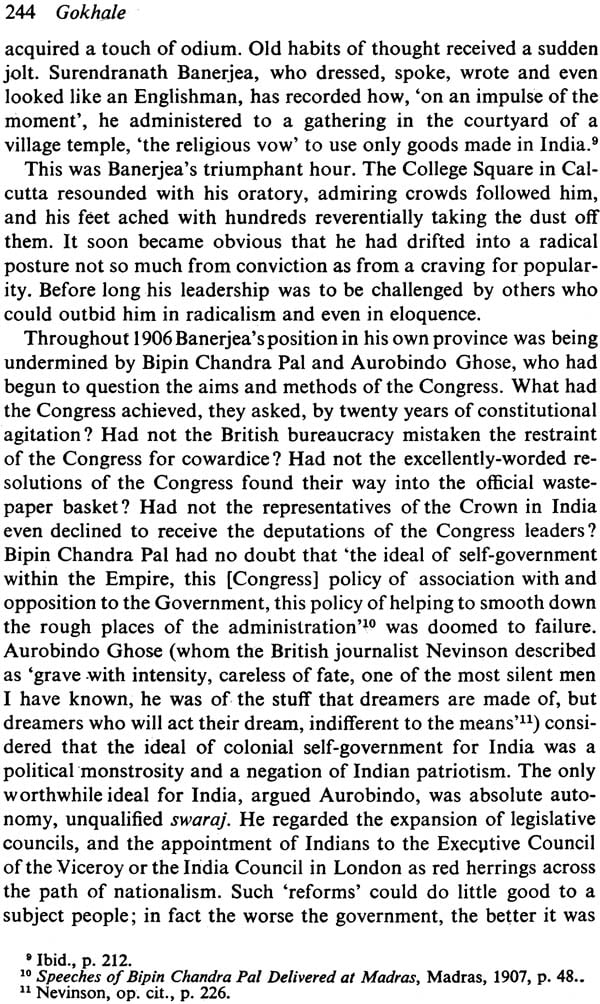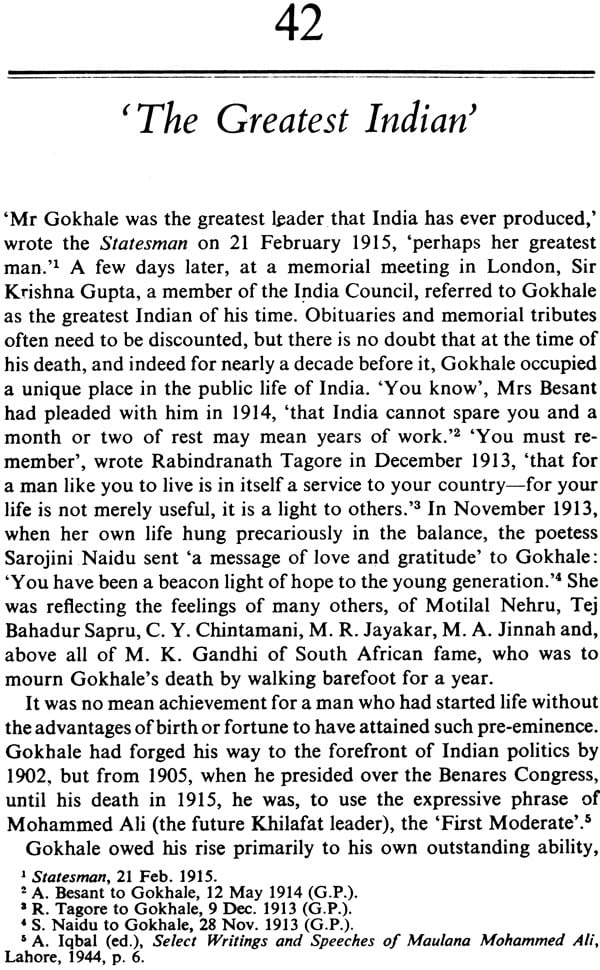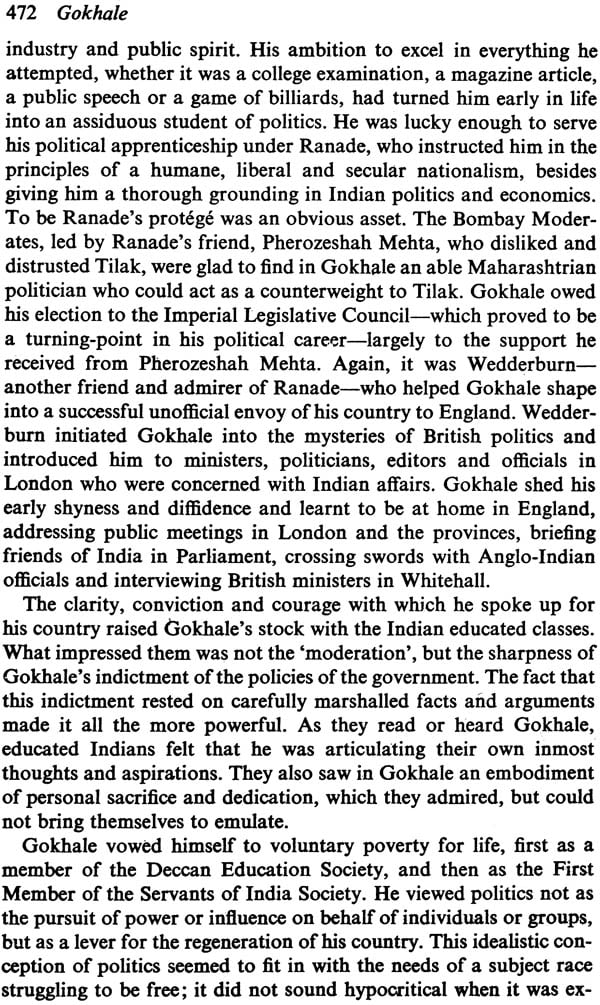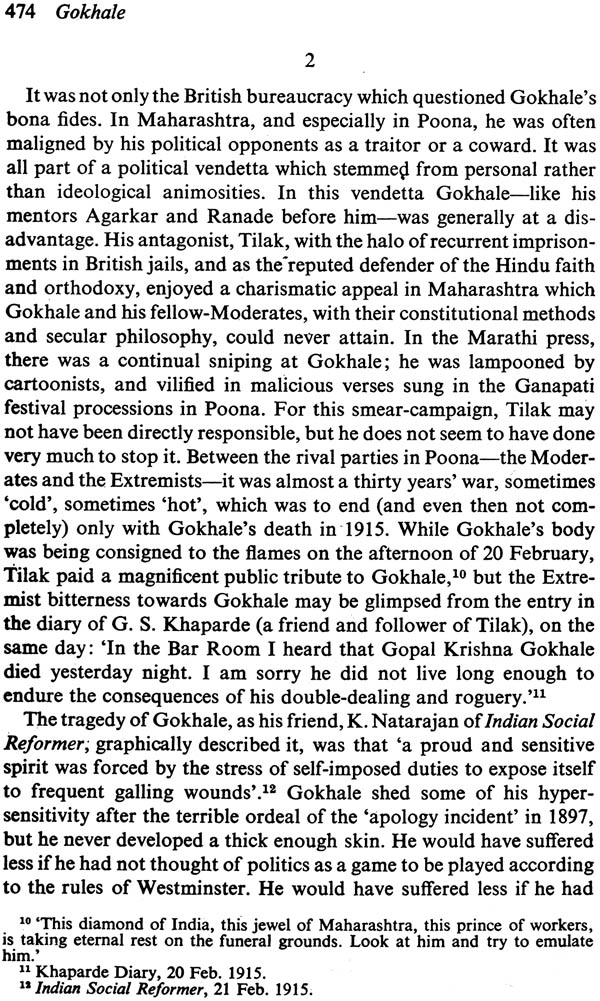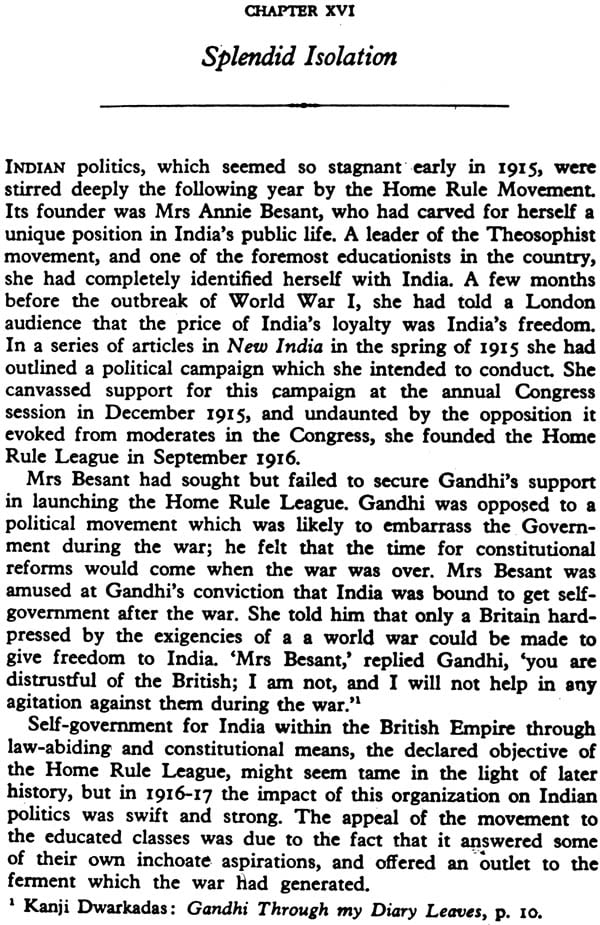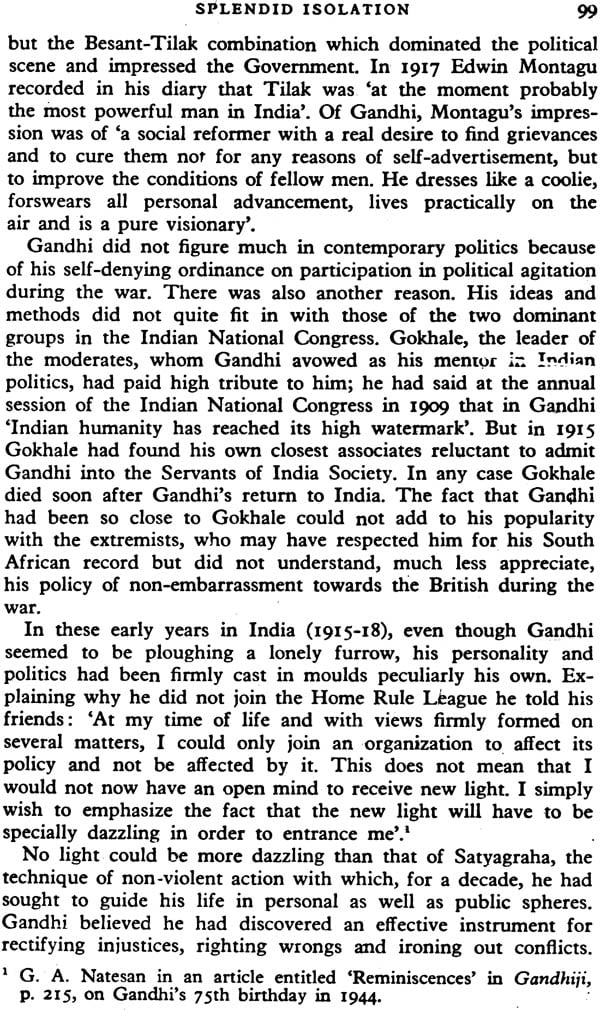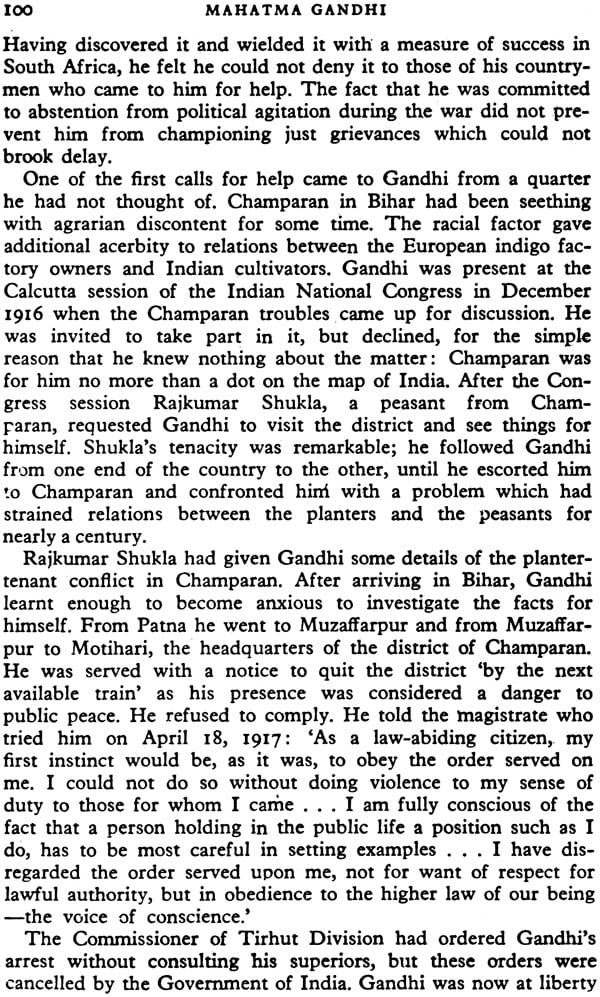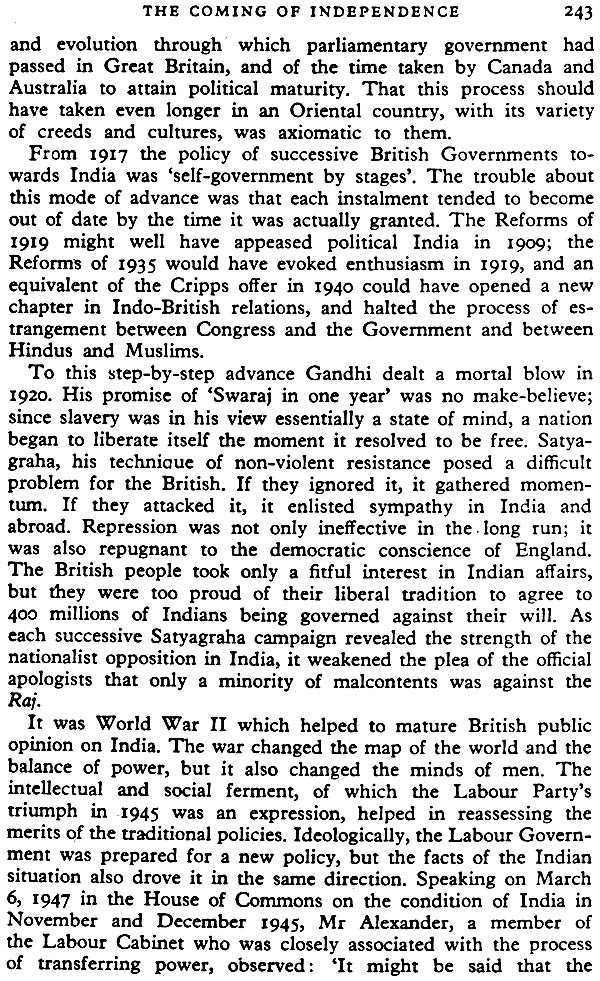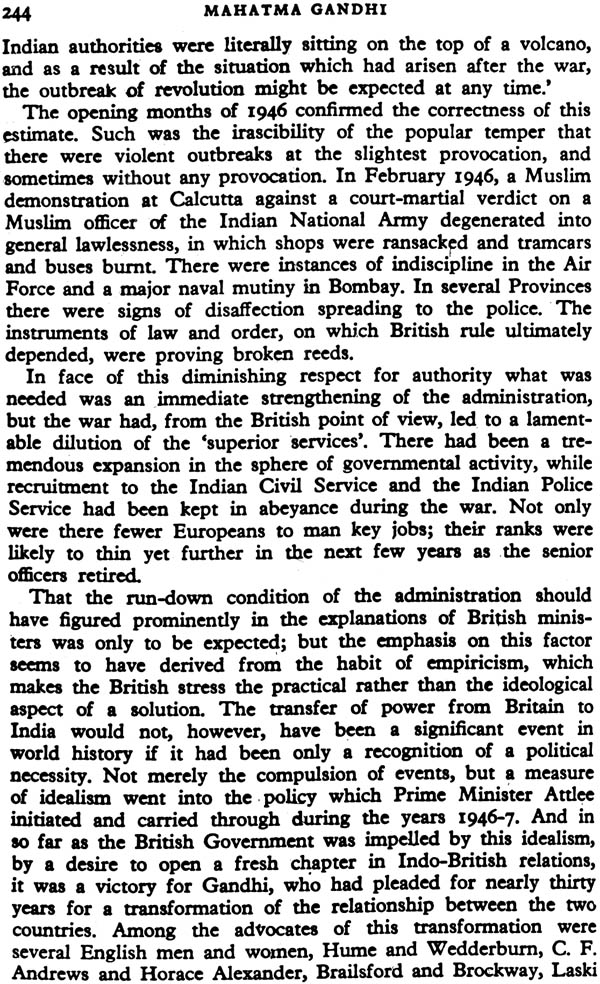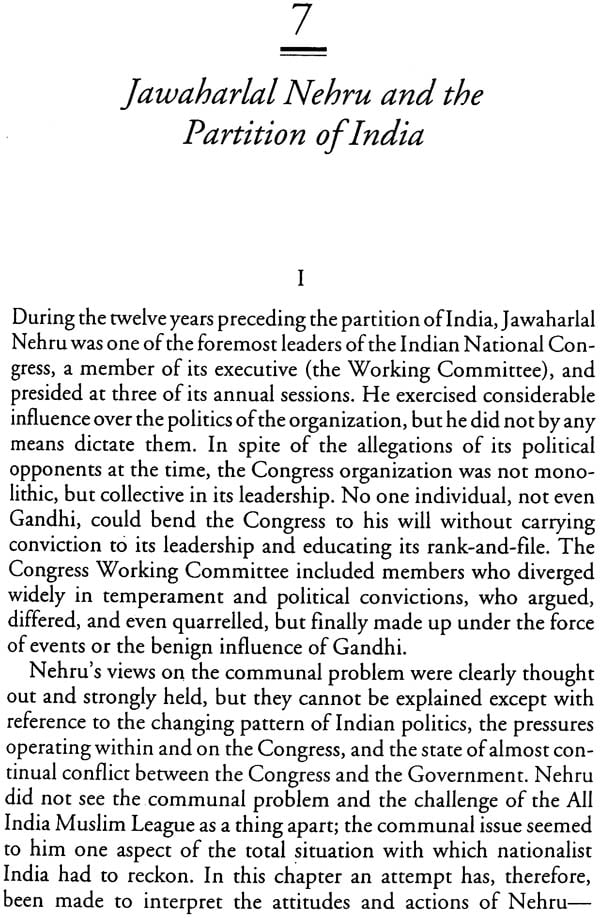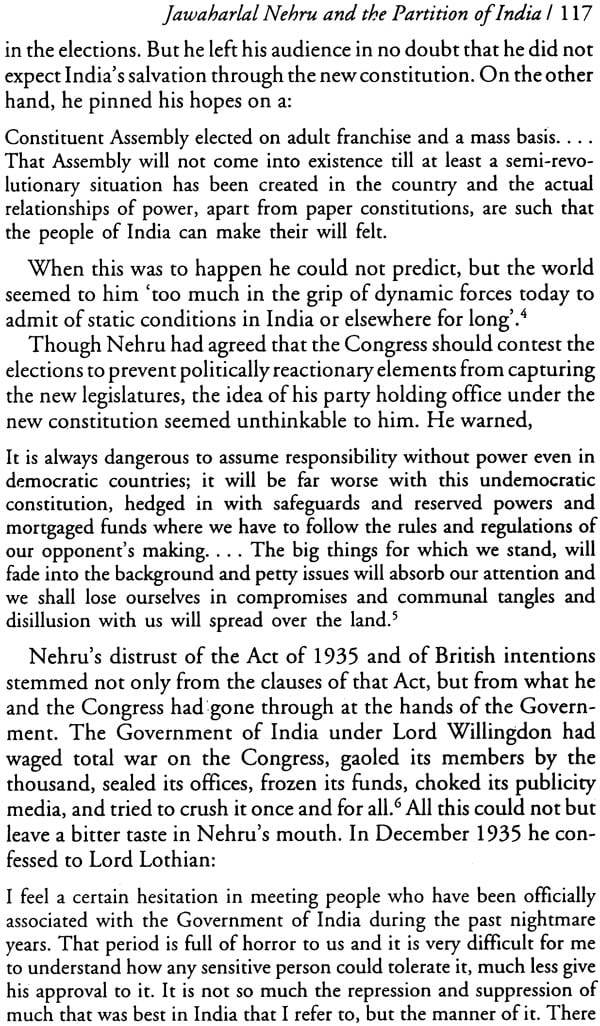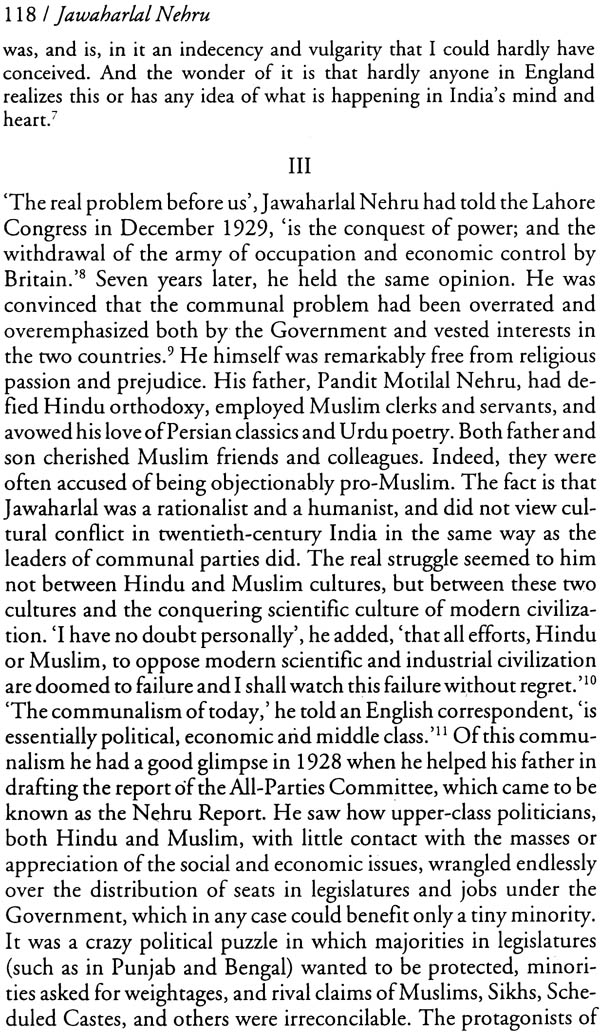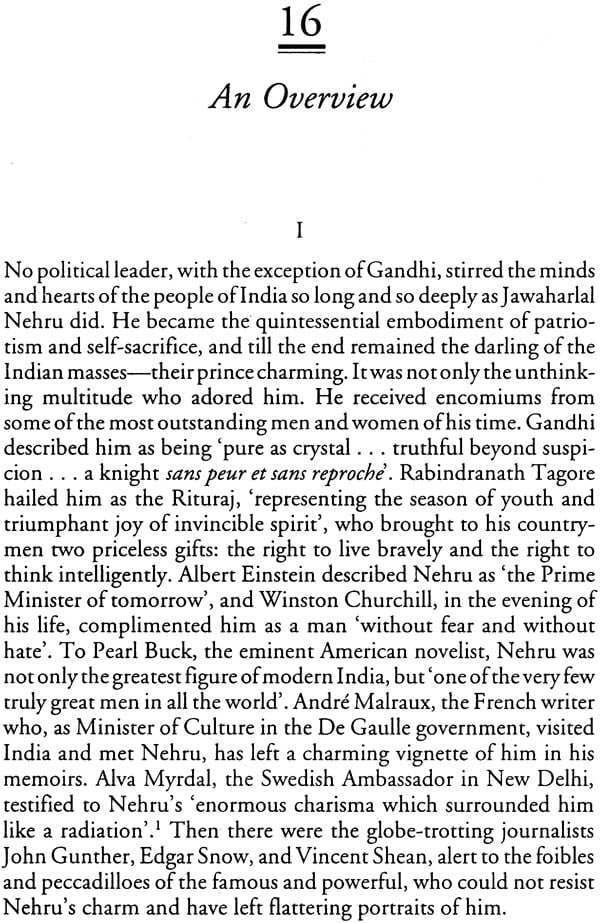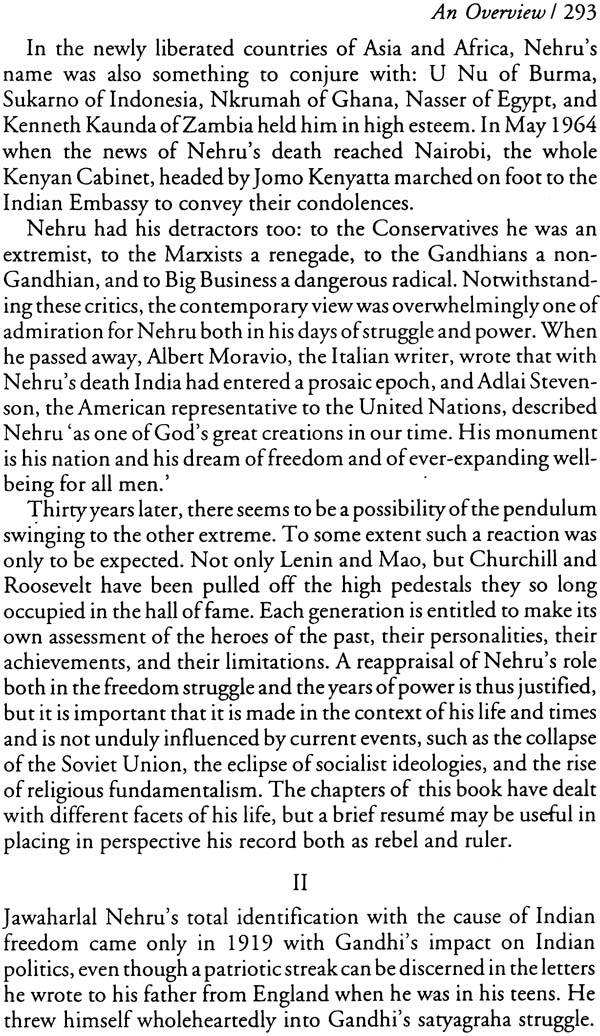
Three Statesmen - Gokhale, Gandhi, and Nehru
Book Specification
| Item Code: | NAL808 |
| Author: | B.R. Nanda |
| Publisher: | Oxford University Press, New Delhi |
| Language: | English |
| Edition: | 2015 |
| ISBN: | 9780199457519 |
| Pages: | 1170 (21 B/W Illustrations) |
| Cover: | Paperback |
| Other Details | 8.5 inch X 5.5 inch |
| Weight | 1.10 kg |
Book Description
In an exploration of three charismatic leaders, B.R. Nanda- one of India’s foremost historians of the freedom movement- makes a comparative study of their backgrounds, temperaments, and ideologies. He analyses in detail how they differed significantly in manner and style but shared a common vision of the unity and freedom of India. Followed by the introduction, in three separate works, Nanda examines the lives of these three leaders in relation to their eras. These, therefore, are both biographies and histories of critical times- relating personalities to periods and leaders to the societies they lived in. The volume focuses on the inter-relationship between their ideas and methods and how these remain relevant today. The past, says Nanda, as seen through the lives of Gokhale, Gandhi and Nehru, informs the present and has many lessons for India and the world today.
B.R. NANDA (1917-2010), Founder and former Director of the Nehru Memorial Museum and Library, was a leading historian of modern India.
‘B.R. Nanda’s biographical writing have added a new dimension of understanding to the lives and works of three great Indian patriots.’
I am glad that three of my books on Gokhale, Gandhi, and Nehru are being published in the omnibus edition. Gokhale, the eldest of the trio, was born in 1866, and Jawaharlal Nehru, the youngest, died in 1964. Thus, the three of them together spanned an eventful century of modern India history. Their relationship with each other, and impact on the India nationalist movement, is sketched briefly in the introduction to this volume and, of course, at these length in the books.
As the author of these three biographical studies, I would like to say that I am basically a historian who has used biography not only for the recreation of the lives of these outstanding figures, but also for recreating an important epoch in Indian history. For me, as a biographer, both the man and the period were equally important; the period needed to be explored in depth to provide the political and social context, but the personality had also to stand out. In these books I wanted to understand how they tried to space events and how the events shaped them; history was treated not just as a backdrop; but as an essential part of the unfolding drama of their lives. Such an approach, difficult as it was, seemed to me to me feasible, because I was writing on men who had been sucked into politics at an early age, were in the centre of the national stage, and whose personal lives completely merged into, and were almost submerged by, their public lives.
While writing these biographies I had to cope with an enormous amount of published and unpublished material. I, therefore, resorted to a combination of chronological and thematic modes; this was especially so in the books on Gandhi and Gokhale. In the book on Nehru, the arrangement was roughly chronological, but the treatment mainly thematic, so that I could engage more deeply with various aspects of Nehru’s life, thought, and political career.
Few men in their lifetime aroused stronger emotions or touched deeper chords of humanity than Gandhi. ‘Generations to come, it may be,’ wrote Einstein of Gandhi in July 1944, ‘will scarcely believe that such a one as this ever in flesh and blood walked upon this earth.’ While millions venerated Gandhi as the Mahatma, the great soul, his political opponents saw in him only an astute politician. Not until 1946-7, when the transfer of power enabled them in their minds to disengage Mr Gandhi the man from Mr Gandhi the arch-rebel, where the Britsh able to see him in a gentler light. And it was his tragic death which finally convined his Pakistani detractors that his humanity encompassed and transcended his loyalty to Hinduism.
It is not easy to write the life-story of a man who made such a strong impact on his contemporaries. Yet it is important that the image of Gandhi does not become that of a divinity in the Hindu pantheon, but remains that of a man who schooled himself in self-discipline, who made of his life a continual process of growth, who shaped his environment as much as he was shaped by it, and who tenaciously adhered to certain values to which civilized humanity pays lip-service while flouting them in practice.
Though the arrangement of his biography is necessarily chronological, I have attempted at appropriated points to analyse Gandhi’s attitude to important issues. The background of Indian nationalism, the Indian political scene when Gandhi returned from South Africa, his religious evolution, the transformation in his mode of life and acquisition of new values, his ethics, economics, and political movements, his attitude to war and un-touchability-all these have been treated in separate chapters. This combination of the chronological and the analytical methods has facilitated the discussion in a single volume of Gandhi’s long and many-sided life in some detail, and the correlation of the story of his life with the evolution of his ideas. Gandhi was no theorist; his principles evolved in response to his own needs, and the environment in which he found himself. In fact, it is as difficult to assess the events of his life without understanding the ideas which inspired him, as it is to interpret his ideas on religion, morals, politics, or economics without reference to the context of his own life.
I know how hard it is for one who has lived through the last forty years to be completely objective about the events of which Gandhi was the centre, but in assessing and reassessing events and personalities, it has been my endeavour to understand and to interpret in the historical perspective, rather than to uphold or to condemn. How far I have succeeded in this endeavour it is for the reader to judge.
I am grateful to the Government of India and the Director of the National Archives for permission to examine and use material from contemporary records, which have enabled me to present, for the first time I believe, a two-dimensional story of Gandhi’s relations with the government,. Any account of Gandhi’s struggles which is wholly, or even largely based on official sources is, however , apt to be lopsided. I have therefore used these sources only to illuminate some of the obscurer spots, and to see events in their proper perspective.
I am grateful to Mr V. K. Krishna Menon, Mr Pyarelal and Kaka Seheb Kalelker, who were good enough to discuss and elucidate certain points. Among those who evinced keen interest in the progress of this book I must mention Mr Devadas Gandhi, who unfortunately did not live to see it; and Mr N. C. Chaudhuri, Mr K. P. Mushran and Mr M. K. Kaul gave me much encouragement.
Mr B. N. Khosla read the entire book in manuscript and made useful suggestions. I alone, however, bear responsibility for the views expressed in the book and for its shortcomings .
I am indebted to my wife for her encouragements and patience during the long hours of silence in which this book was composed.
The three statesmen, Gandhi, Gokhale, and Nehru, had much in common. They were all drawn into public life at a yough age. They were charismatic leaders who made a significant contribution to the Indian freedom movement. Notwithstanding differences in their social background, temperaments and world views, they worked together for a common cause and gave to their country two successive fruitful political partnerships-between Gandhi and Gokhale and between Gandhi and Nehru.
Gandhi’s first meeting with Gokhale took place in Calcutta in November 1896. ‘Love at first sight’, this was how he described it in his autobiography. Gokhale was a little older than Gandhi, but this was not the only reason for the obvious respect, almost reverence, with which Gandhi treated him from the beginning. In 1896 Gandhi was only twenty-seven and Gokhale thirty. While Gandhi was a little-known lawyer and leader of the small Indian minority in distant South Africa, Gokhale was a prominent educationist, editor, and politician in the centre of provincial and national politics in India. The very first letter written by Gandhi after meeting Gokhale shows that he had cheerfully accepted the role of a disciple. He sought Gokhale’s cooperation in raising the problems of Indians overseas in the Imperial Legislative Council at Calcutta and in the House of Commons, if ’the Indian enterprise outside India was not to come to nought.’ Thus began a life- long friendship which was cherished by both, and gave much needed moral support to Gandhi in his twenty years’ long struggle against racial discrimination in South Africa. Five years later, in January 1902, while addressing a public meeting in Albert Hall in Calcutta, Gokhale paid a tribute to Gandhi’s work in South Africa and his ‘ability, earnestness and tact and also his manner, at once so gentle and yet so firm.’ Gokhale went on to say that Gandhi was ‘made of the stuff of which heroes were made; if he settled in this country [India] it was the duty of all earnest workers to place him, where he deserved to be, at their head.’ Gokhale’s admiration for Gandhi grew with the years. In 1909, at a public meeting in Bombay held to protest against the treatment of Indians in South Africa, Gokhale spoke of the ‘indomitable Gandhi, a man of tremendous spiritual power, one who is made of the stuff of whish martyrs are made.’
With hindsight it seems that one of Gokhale’s greatest services to his country was his prescience in recognizing Gandhi’s potential and in mobilizing the support of Indian opinion and the sympathy of the Viceroy and the Government of India in the last phase of Gandhi’s satyagraha campaign which paved the way for Gandhi-Smuts agreement in 1914. But for this agreement , Gandhi may have been bogged down in a hopeless struggle in South Africa, and his return to India would have been indefinitely delayed, with incalculable consequences for him and for the future of the Indian struggle for freedom.
The Gokhale-Gandhi partnership ended with Gokhale’s untimely death in February 1915 soon after Gandhi returned to India. The Gandhi-Nehru partnership was to last longer; it began in 1919 and ended only with Gandhi’s assassination in 1948. Though divided by twenty years of age intellectual and temperament differences, Gandhi and Nehru developed bonds of mutual respect and affection. Their differences occasionally subjected their political partnership to severe strains, but they were never pressed to the breaking point, much to the disappointment of the British authorities. We get a glimpse of the British view of the Gandhi-Nehru partnership in a letter written on 13th February 1938 by an American journalist, Francis Gunther, to Jawaharlal Nehru after a meeting with the Viceroy, Lord Linlithgow:
| Praface | vii | |
| Introduction to the Omnibus | ix | |
| Gokhale | ||
| The India Moderates and the British Raj | ||
| BOOK I: | FORMATIVE YEARS | |
| 1 | Early Life | |
| 2 | Ferment in Maharshtra | |
| 3 | Emergence of the Educated Elite | |
| 4 | The Indian Jesuits | |
| 5 | Apprenticed to Ranade | |
| 6 | The Yough Politician | |
| 7 | Professor Gokhale | |
| 8 | On the Congress Platfrom | |
| 9 | The Great Split | |
| 10 | The Rising Star | |
| 11 | Ecilpsed | |
| 12 | The Clouds Life | |
| 13 | Triumph | |
| BOOK II: | SPOKESMAN FOR THE MODERATES | |
| 14 | Gokhale Comes of Age | |
| 15 | Wanted, A Leader | |
| 16 | Servant of India | |
| 17 | Clash with Curzon | |
| 18 | Envoy Extraordinary | |
| 19 | Congress President | |
| 20 | Advocate for India | |
| BOOK III: | CONFRONTATIONS, WITHIN AND WITHOUT | |
| 21 | Morely's Dilemma | |
| 22 | The Extermist Challenge | |
| 23 | The Widending Rift | |
| 24 | Crisis in the Raj | |
| 25 | Road to Surat | |
| 26 | Refroms on the Anvil | |
| 27 | Climax | |
| 28 | Origins of Muslim Separatism | |
| 29 | Gokhale and the Communal Problem | |
| 30 | Separate Electorates | |
| 31 | Anticlimax | |
| 32 | A House Divided Against Itself | |
| 33 | Détente | |
| 34 | Leader of the Opposition | |
| 35 | Educating the Masses | |
| BOOK IV: | THE LAST PHASE | |
| 36 | Educating the British | |
| 37 | Gandhi and Gokhale | |
| 38 | Crisis in South Africa | |
| 39 | The Last Battle | |
| 40 | No Reunion | |
| 41 | Last Days | |
| 42 | 'The Greatest Indian' | |
| 43 | The End of an Era; | |
| Bibliography; | ||
| Index. | ||
| Mahatma Gandhi (A Biography) | ||
| 1 | Preface | |
| 2 | Childhood | |
| 3 | Off to England | |
| 4 | Briefless Barrister | |
| 5 | A Fateful Journey | |
| 6 | Plunge into Politics | |
| 7 | Lynuched | |
| 8 | Stones for Bread | |
| 9 | The Religious Quest | |
| 10 | Transformation | |
| 11 | Discovery of Satyagraha | |
| 12 | First Satyagraha Movement | |
| 13 | Second Round | |
| 14 | Final Phase | |
| 15 | A Hero on Probation | |
| 16 | Indian Nationalim | |
| 17 | Splendid Isolation | |
| 18 | Shadow of Amritsar | |
| 19 | Road to Rebellion | |
| 20 | Swaraj within a year | |
| 21 | Climax | |
| 22 | Anticlimax? | |
| 23 | Councils and Communities | |
| 24 | From the Bottom Up | |
| 25 | The Rising Tempo | |
| 26 | Year of Grace | |
| 27 | Civil Disbobedience | |
| 28 | Truce | |
| 29 | The Round Table Conference | |
| 30 | Total War | |
| 31 | Harijans | |
| 32 | Rural Economics | |
| 33 | Congress in Office | |
| 34 | The Genesis of Pakistan | |
| 35 | India and the War | |
| 36 | The Widening Rift | |
| 37 | Quit India | |
| 38 | No Defeat | |
| 39 | The Coming of Independence | |
| 40 | Quenching the Flames | |
| Victory of the Vanquished; | ||
| Epilogue; | ||
| Index. | ||
| Jawaharlal Nehru (Rebel and Statesman) | ||
| 1 | The Young Nationalist | |
| 2 | The Triumvirirate: Gandhi, Motilal, and Jawaharlal | |
| 3 | Gandhi and Jawaharlal | |
| 4 | Playing for High Stakes | |
| 5 | Nehru and Bose | |
| 6 | Nehru and Religious | |
| 7 | JawaharlalNehru and the Partition of India | |
| 8 | Azad, Nehru, and Partition | |
| 9 | Nehru and Socialism | |
| 10 | Letters to Chief Ministers | |
| 11 | Economic Planning | |
| 12 | Nehru and Non-Alignment | |
| 13 | Nehru and the British | |
| 14 | Nehru as a Man of Letters | |
| 15 | The Autobiography | |
| 16 | An Overview; | |
| Index. |

